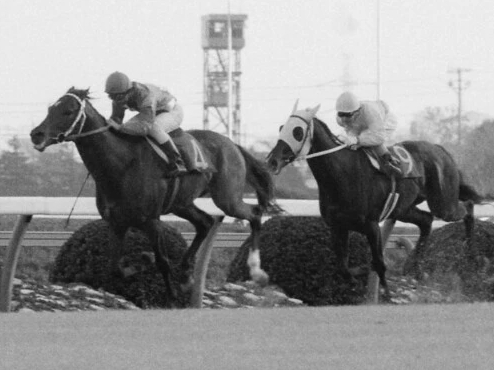In the history of Japanese horse racing, few names resonate as powerfully as Symboli Rudolf. Known as “The Emperor”, he became Japan’s first undefeated Triple Crown winner, achieving seven GⅠ victories and setting a benchmark for perfection on the turf. Even decades after his retirement, his name still commands respect among racing fans, historians, and breeders.
1. Early Life and Background
Symboli Rudolf was born on March 13, 1981, at Symboli Farm in Hokkaido’s Monbetsu Town. Bred from racing royalty, he was sired by Partholon and out of Sweet Luna, herself a daughter of the legendary Speed Symboli. From the very start, he displayed remarkable strength and composure—standing up just 20 minutes after birth, with a distinctive crescent-shaped mark on his forehead.
His upbringing reflected the meticulous care of owner-breeder Wada Tomohiro and trainer Yuji Nohira, who adopted a European-style training philosophy emphasizing versatility and racecraft.

2. The Making of an Emperor
From sprints to marathons, Symboli Rudolf was a master of all distances—winning races from 1000 meters to 3200 meters. He possessed both tactical adaptability and the mental sharpness to respond instantly to his jockey’s cues.
“They say there are no absolutes in horse racing, but with Rudolf, there is.”
This rare blend of athleticism and intelligence earned him the nickname “The Emperor”, and it wasn’t long before he was on a path to history.
3. Undefeated Triple Crown Glory
Symboli Rudolf debuted in 1983, winning three straight races as a two-year-old. In 1984, he captured the Satsuki Sho (Japanese 2000 Guineas), Tokyo Yushun (Japanese Derby), and Kikuka Sho (Japanese St. Leger)—becoming the first undefeated Triple Crown winner in Japanese racing history.
The Kikuka Sho was the crowning moment, a display of patience, power, and precision.
4. International Aspirations and Setbacks
After dominating domestically, plans were made for overseas challenges, including the King George VI & Queen Elizabeth Stakes in the UK. However, injuries and scheduling conflicts altered his course, and his most notable international test came in the 1986 San Luis Rey Stakes in the USA—his final race before retirement due to injury.
Despite these setbacks, his domestic record remained extraordinary: 13 wins from 16 starts, including two Arima Kinen victories, the Tenno Sho (Spring), and the Japan Cup.
5. Racing Style and Strengths
While best known for his good-position-and-burst finish style, Symboli Rudolf was versatile—capable of front-running or closing from behind when needed. His acceleration was fueled by an extraordinary stride, measured at around 8.7 meters during his Derby run—far above the average Thoroughbred stride length.
He was also mentally resilient, often holding his lead foot longer than other horses, conserving energy and maintaining balance through turns. This made him a master tactician on the track.
6. Stud Career and Legacy
Upon retirement, Symboli Rudolf stood at stud at Symboli Farm, producing champions such as Tokai Teio, who also became an undefeated dual Classic winner. Other notable progeny include Airton Symboli and Tsurumaru Tsuyoshi. While his sire line eventually faded, his influence endures through bloodlines, racing lore, and the standards he set for excellence.
7. Honors and Cultural Impact
- JRA Hall of Fame (1987)
- Ranked among Japan’s all-time greatest racehorses in fan and expert polls
- Featured in commercials, documentaries, and commemorative events
- Inspired the sake brand “Seven Crown Horse”
Even today, the phrase “absolute certainty” in Japanese racing circles often recalls the dominance of Symboli Rudolf.
Conclusion
Symboli Rudolf was more than just a racehorse—he was a symbol of unbeaten excellence, adaptability, and mental fortitude. His undefeated Triple Crown remains a milestone in Japanese racing, and his story continues to inspire new generations of fans and horsemen.
Further Reading:
External: The Legacy of Symboli Rudolf – Yushun Web
Internal: Favorite Horses – Horse Racing Stories






コメント